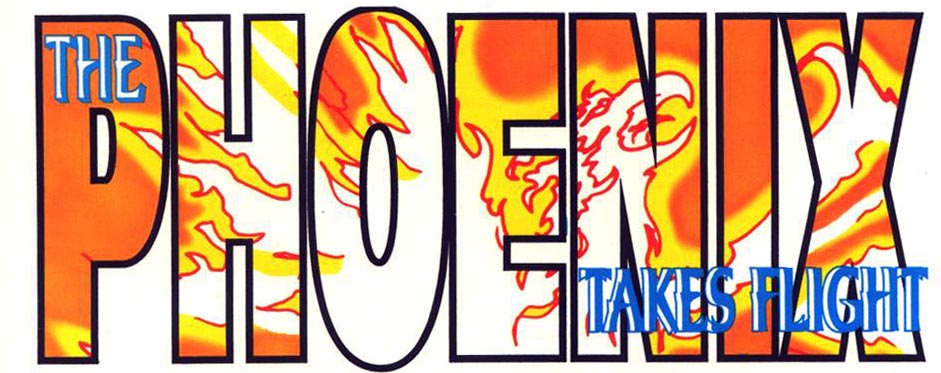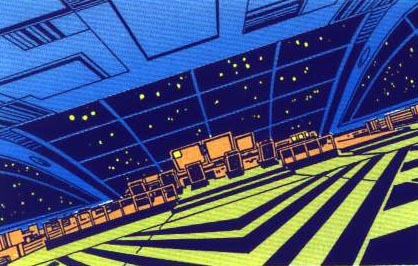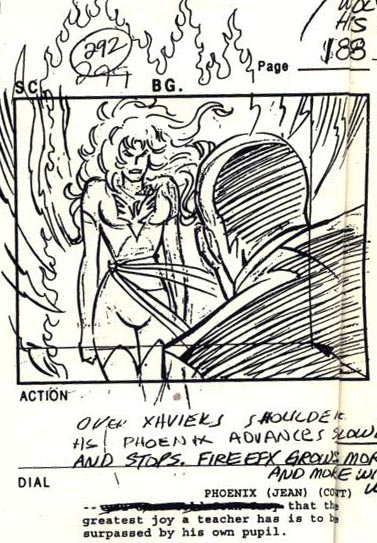

Written by Tom Russo

A storyboard from "Out of the Past," illustrated by Larry Houston
Stephen King's The Stand may have been considered by many the epitome of the apocalyptic TV mini-series, but that was before "The Dark Phoenix Saga" hit the screen.
Jean Grey's tragic metamorphosis from woman to goddess to universal scourge -- one of the classic Marvel storylines -- is about to assume the stature of an animated classic. A five-part Phoenix story and a Dark Phoenix four-parter form the tiwn pillars of this season's X-Men episode lineup on FOX.
The first round of Phoenix shows is even airing as a "strip" -- broadcast daily -- so when "Phoenix" blazes into viewers' living rooms over five consecutive weekday afternoons this September, it will mark the first show in the new X-Men animation series to move out of its weekend slot to run during the week. X-Men will then return to Saturday, with "Dark Phoenix" slated to run over four weeks during the November ratings sweeps.
"Phoenix" and "Dark Phoenix" have been conceived, not just as stories in the spirit of the originals, but as genuinely faithful adaptations. "Jean Grey went out and mutilated several solar systems, and we can't really do that, but within certain limitations we're trying to be true to the books," X-Men Supervising Producer Scott Thomas said. "We know how popular the Phoenix storyline was, so we're trying to do it justice."
Many of the show's animated tableaus will look strikingly familiar. Producer Larry Houston, who oversees the visuals on X-Men, sent copies of the DARK PHOENIX trade paperback to his animators, instructing them to borrow liberally, and while artists studied John Byrne's distinctive style, writers boned up on Chris Claremont's storytelling technique.
"Of all the shows we've done, 'Dark Phoenix' is closest to the comics," said Joe Calamari, series executive producer and longtime Marvel executive. "The lines are quoted almost directly from the comic balloons. Time is the only consideration -- there's just a lot more time involved in reading comic dialogue, believe it or not, than in reading script dialogue. There's only a third of the verbiage in the script, because you can't have people saying two or three lines at a time. Something has to be moving on the screen."
"Over the first two seasons, there were only two or three episodes that were based on a specific book," Story Editor Eric Lewald said. "There was a very loose adaptation of 'Days of Future Past' (UNCANNY X-MEN # 141), and besides that, the books were basically used as research for bits of character and incidents, and the stories themselves were original.
"'Dark Phoenix' translated fairly closely," he said. "The Phoenix storyline itself took a little more finagling, because it was pieced together from a dozen books with five or six subplots. The X-Men would be in Ireland, and then there were leprechauns, and then there were Shi'ar...Everything was from the books, but it took more cutting and pasting to make a coherent five-part television story. [X-Men Group Editor] Bob Harras was telling us, 'Don't think of the whole comic book as the 'Phoenix' story, think of it as eight pages from this one and eleven pages from that one, and pick and choose.' That was the way we had to do it to keep the story straightforward."

A background from Mojo-World
Still, "Phoenix" and "Dark Phoenix" will be rich with detail -- strong, dramatic characteriztion qne plot intricacies are what first attracted FOX to the comic, and the network has made these elements a mandate for the show. "This is the generation that's computer literate," noted Sidney Iwanter, who, as FOX's executive director of children's programming, provides direction for X-Men, Batman, and Spider-Man. "If our core audience has the patience and intelligence to go through tweleve levels of a Sega or Nintendo game, then they're patient and intelligent enough to follow X-Men. We do not talk down to our viewers."
One secret to X-Men's unusual maturity, Scott Thomas explained, is that the program draws heavily on the thriving arts community in Toronto, where all the dialogue is recorded. "The people doing the voices are mainly theater and television actors -- they're not necessarily 'cartoon voices,'" he said. "We've gone out of our way to find actors, because this is played more like a drama, as opposed to traditional animation, where everybody's screaming at the top of their lungs. There's actually a lot of emotion and some nice scenes going on between the actors."
The entire X-Men production process involves delicately balanced -- but potent -- artistic collaboration. Unlike the new Spider-Man and Marvel Action Hour series, which are put together by Marvel Films Animation, X-Men is produced by Saban Entertainment. Saban has been charged by Marvel and FOX with the responsibility of realizing their vision for X-Men, from script to screen. It's a formidable enough task that Saban employs a studio called Graz Animation to handle the show's design, mapping out storyboards, and coordinating the efforts of animation teams in Korea, China, and the Philippines. The visuals then come back to Saban for final editing, with Calamari and Iwanter contributing key input.
The system is complex, Calamari admitted, and Marvel has at times reinvested its X-Men royalties back into the show to work out the kinks and ensure maximum quality. But with two 13-episode seasons already logged, X-Men is by now running like the proverbial well-oiled machine, so Lewald and his writers have had an opportunity to deal with fundamental story development, putting themselves in a position to tackle meaty concepts like "Phoenix" and "Dark Phoenix."
"In the comic, there are a lot of detailed stories which would be difficult to do at any other time, unless you really know the characters," Thomas said. "I think it's the right time now. This is the third season, people know the world we're in, and we can take a certain amount of story license."
"In the meetings I've always stressed that they should get to the Phoenix stories, to stories at the heart of the X-Men mythos," said Harras, who serves as an editorial consultant on the series. "I constantly tell them to take a look at the books and see what's going on there that could inspire them, rather than comping up with storylines wholesale. That was the big edict, actually, from [FOX Children's Network President] Margaret Loesch when we went ahead with the show...it had to be very much like the Marvel comic books."
With an X-Men legend spanning three decades and no fewer than eight current comic book titles, the new episode lineup had to be whittled down from a list of some 50 choice storylines. "We pick up two or three shows in each group of thirteen to really develop characters," Calamari said, "and then a few small series, two and three-parters, to give the show a flow."
The '94-95 season opens with a two-part encounter between Wolverine and Lady Deathstrike, with the conclusion written by Len Wein, writer of the immortal GIANT-SIZE X-MEN #1. Other non-Phoenix stories will likely include episodes spotlighting Iceman and Archangel, a showdown between Colossus and Juggernaut [DRG4's note: This episode never winded up happening], a two-part return to the Savage Land, and a character piece in which Cyclops learns The Starjammers' Corsair is his father. Nightcrawler, Bishop, and Magneto's Asteroid M sanctuary will turn up either this season or next, pending final scheduling. "We're trying to play catch-up with the continuity in the books, so what we're doing is bringing in the best stories," Houston said. Houston and company have a finite number of chapters in which to interpret X-Men history (65 episodes officially, with more possible should FOX agree to Calamari's recently proposed extension), and some plot divergences are unavoidable.
"Throughout the course of the book, there have been all sorts of different takes on characters," Lewald said. A case in point: "You've got Magneto as this evil, sadistic, nasty, murderous, destructive guy, and then a few years later he's helping to run The X-Men. There may be half a dozen different ways that Marvel has treated Magneto over the years. We knew we would be seeing him several times on the show, so we picked the mixture we felt would provide the most rewarding character development. We made him a ruthless guy, but we also showed that he and Xavier have deep respect for each other. And once we've decided what a character's history is, we stick with that."

An interior background of a Shi'ar Shuttle
Similarly, Lewald said, "We had to make a choice about having our X-Men be in their mid-20s and 30s, as opposed to teenagers. We don't refer to the mansion as Xavier's School for Gifted Youngsters much at all, because [although] that's what it was in 1963, that isn't really what it is now." Xavier's digs will be a focal point for revisionist storytelling this season, as the animators incorporate designs from the X-MEN: SURVIVAL GUIDE TO THE MANSION. Since this face lift can't be traced to any single development in the comics, the writers are introducing a plot device that will at once explain the change and play into the Phoenix storyline.
During the Lady Deathstrike two-parters, Houston said, "The X-Men discover that centuries ago, a Shi'ar spaceship crashed, and it's buried 'way beneath New York City. In subsequent episodes we'll make a reference to that, as Beast creates different devices that have been augmented by this Shi'ar technology." By the time Shi'ar spacecraft warp onto the scene in 'Phoenix' and 'Dark Phoenix,' they'll be thoroughly identifiable flying objects, for The X-Men and viewers alike.

A storyboard from the "Dark Phoenix Saga," illustrated by Doug Murphy
The X-Men are unusual in that they rose to their current prominence, not in the '60s, but in the late '70s and early '80s -- a less innocent time, and one in which comic book publishers were more willing to explore controversial themes. Psychologically edgy characters like Wolverine and Phoenix tested new ground in comics, and they're doing the same in animated television today. Here again, plot adjustments are sometimes a neccessity. "We generally take a first pass at our stories, [staying] pretty close to the comics," Calamari said, "but we run into broadcast standards and practice issues quite often, and that's where we really have to sit down and start looking at changes.
"Looking at the whole picture, those changes have been relatively small," he continued. "We can't have a character kill, or say, 'I'm gonna kill you!' When there are close-ups, we can't have Wolverine popping his claws up under somebody's chin. But we can say, 'Destroy them,' and we can cut up things that are robotic."
"Wolverine is probably the embodiment of every TV broadcast standards person's nightmare," Lewald added with a laugh. "It's the kind of thing every nine-year-old loves to hear -- 'Oh, boy, Wolverine is acting out and really ripping into people!' -- but on TV we have to have a Wolverine who's more careful than that. It's difficult sometimes, because so much of the drama is in his attitude. One way we can do this sort of thing is to show a character struggling with what he's doing. That makes it easier for broadcast standards to swallow, so we've got even more angst than there is in the books sometimes.

A model sheet image of one of the Starjammers
"Phoenix is a perfect example," he said. "Jean goes crazy, becomes this immensely powerful creature, and slaughters six billion people. Then she realizes what she's done, and out of utter guilt and anguish, commits suicide. I have a whole lot of sympathy for broadcast standards on this -- they don't particularly want Jean, however upset and irradiated she is -- to be eating plants and melting people. They're more comfortable with a storyline where it's an entity inside Jean doing this, and she's fighting against it."
Lewald credits FOX's broadcast standards department with being supportive of some fairly radical ideas, and the changes being made to the "Phoenix" saga actually dovetail nicely with an ongoing effort to "retrofit history," as the X-Men creative team frequently put it. In this case, readers of the book saw Jean Grey die in the X-Men's last stand against the Shi'ar, only to be told years later that it was instead a cosmic spirit who had expired on the moon. To satisfy those readers, the show must accommodate both scenarios.
"Sometimes there are things in the book that we don't think will seem plausible anymore to TV audiences," Lewald said. "Just saying, 'boom, there's some radiation,' and then Jean is running around as the Phoenix -- that seemed a little old-fashioned. It made more sense to have this entity involved."
"We haven't stayed locked into history," Calamari summed up. "But the things we are developing out of the past are generally stories that most people in comicdom think were the best and greatest. We've just designed those shows to be contemporary, to be around where Bob Harras is in the comics right now.
"It's like knowing the future of where you're going," he said. "And the history of where you've been."
This page is a part of DRG4's Marvel Cartoon Pages:
Featuring Spider-Man, X-Men, Fantastic Four, Iron Man, Incredible Hulk, and the Silver Surfer.